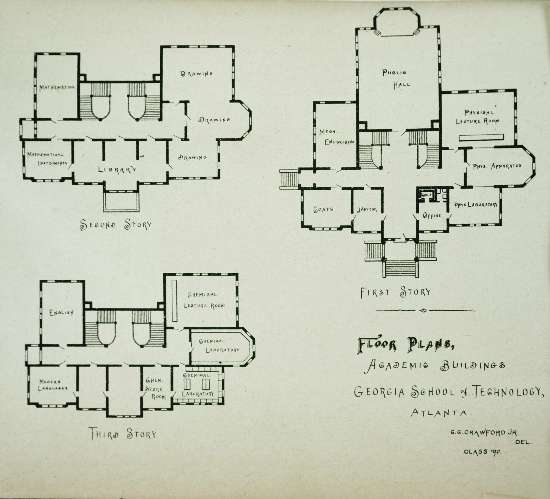 |
gtanno188889-32b
Location:
T171 .G42 G49x 1888-1899
Title: Date:
Floor plans, Academic Buildings, Georgia School of Technology, Atlanta
1889
Content:
Drawing of the floor plans for the 1st, 2nd and 3rd floors of the Academic Building, 1888-1889 in the Annual
Catalogue of the Georgia School of Technology, Announcement for 1888-'89.
History:
The Academic Building, completed in 1888, was designed by the prestigious Atlanta architectural firm, Bruce
and Morgan and constructed by contractor Angus McGilvray, for a total cost of $43,250 in state funds. The
Academic Building was one of two buildings comprising the Georgia Tech campus in October, 1888 when the
Georgia School of Technology first opened its doors. The Academic Building was considered "the major
academic building of early Georgia Tech" and was used for both teaching and administration until 1959, when
it became exclusively an administration building. The Academic Building, like the Shop Building was
designed in "High Virctorian" style according to the principles of Ruskin. They were built of
Chattahoochee brick, machine pressed brick, and Georgia marble and granite and thus serve as monuments to
the "fledgling industrial South." According to Warren Drury, in his 1984 M.A. Thesis, "The Architectural
History of Georgia Tech," the two buildings "personify in masonry the educational concepts which informed
the very establishment of Georgia Tech, a division of hand and brain which invisioned as of equal
importance, the intellectual and practical pursuits of an educated person." The towers on each building
symbolize the two parts of the educated man. Drury further states that "the justaposition of art and
technics can be seen in the [Academic] Building, which contrasts molded brick ornament with smooth
human-made brick and the rugged artisian granite column capital in the center of the porch with the smooth,
shiny machine-finished marble column." The 1888-89 Announcements describes the Academic Building thus: "a
splendid edifice of brick, trimmed with granite and terra cotta, slate roof. It has one hundred and
thirty feet front, is one hundred and twenty deep and is four stories high above basement story. It
contains ample accomodations in halls, offices, apparatus rooms, recitation and lecture rooms, free hand
and mechanical drawing rooms, library and chapel."